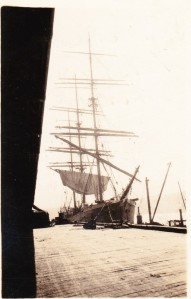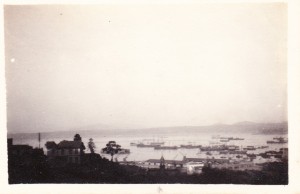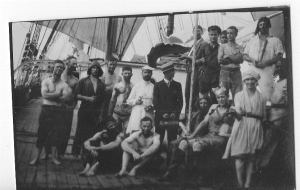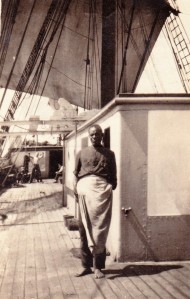A sailor’s life – 80. Worse things happen at sea: the steward’s story

Monkbarns unloading nitrates in Walsh Bay No 10 Sydney, May 1925 (Copyright estate of Eugene Bainbridge)
David Morris called himself a journalist, a writer. He’d been on the lookout for a job on a square rigger for months before he heard of Monkbarns in Sydney in June 1925. He wanted “atmosphere” for some historical sea stories he was preparing to publish, he told the Newcastle Sun as the ship loaded Australian coal for South America. He wanted thrills, he wanted to “see the Pacific at its worst”.
Around him on deck, eyes slid away. “Some of the crew, with that superstition born in seamen, are inclined to regard him us a hoodoo,” the reporter noted.
Three weeks earlier Morris had shot across to Walsh Bay, Sydney, where the ship was discharging nitrate, and buttonholed the mate, offering himself in any capacity at a nominal wage. The mate had said “Nothing doing”, but as he trudged off down the gangway, they’d had a rethink. If he really wanted the experience, said the master, he could come along as a general helper at £2 a month (about £1,000 per annum today.)
Was it a cheap shot they’d expected him to refuse? Morris called himself the Captain’s steward, though he appears on the crew list as Cabin Boy, but pay for a seaman was £10 a month, not £2. Then again, as steward or “boy” he didn’t have to go aloft in all weathers or stand his trick at the wheel. He was a housekeeper, minding stores and dispensing first aid.
“Yesterday Morris was caught sewing his shirt, with stitches that would disgust a housewife, on the steps leading to the poop deck. He is a well-built man of 25, but he looks more like 30. The small moustache on his upper lip, and the tan shoes and the tweed suit already soiled by work in the galley, looked strangely out of place there,” said page 6 of the Newcastle Sun.

Movie poster for The Ship from Shanghai released in 1930 (http://adventures-of-the-blackgang.tumblr.com/
London-born Morris had visited most ports in the world as a passenger, and had slept in some of Australia’s best hotels and its least inviting parks in his quest for “atmosphere”, readers learned. He had been inspired to join Monkbarns by the runaway success of a sea thriller published the previous year by another young Australian journalist, Dale Collins. Ordeal is based on a round-the-world trip Collins made aboard the motor yacht Speejacks as historian to the US cement magnate Albert Younglove Gowen, who happened to be on his (second) honeymoon. The novel – about seamen turning on their idle rich passengers – was filmed in 1930 as The Ship from Shanghai, with Louis Wolheim as the ship’s crazed steward who holds them all hostage.
Morris was quite frank about what he was up to; there were men on Monkbarns who had had remarkable experiences, he told the newspaper, and he wanted to “chase up” some of those real-life stories. But he seems to have fallen short on listening. This may have been a world of horny-handed hard cases risking life and limb in all weathers aloft, but they still wouldn’t set sail on a Friday, or whistle for fear of challenging the wind, or even say “pig” out loud.
Of the 28 men and boys who had left Liverpool in March 1923, one was dead – a 19-year-old apprentice lost lashing down an escaping sail during a hurricane – two had been left behind in hospital injured, and two more would die before they dropped anchor back in the Thames in 1926.

Monkbarns 1923 securing lifeboats under heavy seas off the cape (probably photographed by 3rd mate Malcolm Bruce Glasier)
By June 1925, only the captain, the mate, “Sails”, a couple of ABs and the older apprentices remained of the original company. It was they who had faced down disaster on the passage out, when a hurricane south-west of Good Hope knocked them so badly that the cargo shifted. With the lee side of the ship 12ft under and green seas raking the deck, it was they who had risked their lives deep in the hold, shovelling rock salt uphill for three days to try to right her. Young Cyril Sebun was lost off the upper topgallant yardarm while they laboured. But nothing could have been done to save him. The boats were all smashed.
Eventually, they put into Cape Town in distress – a first for Captain William Davies. “During my forty years of service in sailing ships I have never had an experience that can in any way compare with this recent one, and to be quite frank, I should not like to pass through a similar ordeal again.”
On arrival in Australia, three seamen deserted – abandoning their pay – and Morris’s predecessor killed himself with an overdose of chloroform. He had been drinking heavily, the inquest noted. He was buried in Stockton NSW, where some of his former shipmates from the SS Argyllshire called the following spring. They sang Welsh hymns at his grave, and laid artificial flowers. They knew.
So, it was not surprising that Morris’ taste for ill winds made his shipmates uncomfortable and by the time Monkbarns had been at sea for two months, things had turned nasty.
Three entries from the diary kept by one of the apprentices, Eugene Bainbridge, offer a snapshot: 23.8.25. Sunday. Played Bridge all day and was 600 up to finish. It has been quite parky lately and it was anything but warm at the wheel from 12-2 tonight. Course ENE, on starboard tack. Shaved David Morris’s beard in half deck after putting him forcibly on the floor. He seemed a bit peevish and didn’t play ‘Vingt et un’ very well afterwards. The job we made of his beard wasn’t very good.
24.8.25. Monday. Clear, calm, sunny, fresh. Doing about 2-3 knots. Course ENE. ‘Maurice’ came in for about two minutes tonight. He seemed to know that there was something in the air and beat it.

The Pelican Society photographed by Eugene Bainbridge – Newcastle-Callao 1925 (Copyright estate of Eugene Bainbridge)
25.8.25. Tuesday. A night of revelry of a peculiar sort. The subject was ‘Maurice Moscovich’. Notices were posted on the half deck doors inviting you to a singsong to be held in the fo’c’sle at 6.30pm. The Mate was particularly asked to refrain from blowing 2 whistles and when told why, was quite sympathetic. At 6.30 sharp, we met and the subject [Morris] had wandered into the gay party.
It was a bluff. He was to be seized in the middle of its proceedings and tried by the chief Pelican and his confederates. All passed off as planned and the victim was found guilty of not supplying the fo’c’sle with molasses and duly sentenced to have his port beard and starboard ‘tache shaved off. Cold water was used to emphasise the gravity of the act, and Bill Hughes, the Court Hairdresser, operated.
But worse was to come, because Morris evidently put up resistance to the assault, verbally if not physically. Bainbridge, a 21-year-old ex-boarding school boy from Maida Vale, London, records that the victim was deemed to have been “unduly insolent” to his tormentors – and a vote for death by dropping over the after part of the poop was passed.

Maurice Moscovitch as Shylock at the Royal Court, London, 1919 (From: http://exhibitions.europeana.eu/exhibits/show/yiddish-theatre-es/jml-las-obras/item/130)
It is possible that there was more than a little anti-Semitism in this “hazing” as Maurice Moscovitch was a well known Russian Jewish stage actor that summer wowing Australian audiences with his Merchant of Venice and Morris’s middle name was inscribed on the crew list as Isidor. Bainbridge had been to see Moscovitch at the Criterion theatre while Monkbarns was in Sydney.
More worrying still, the punishment meted out – for poor stewardship of the few treats that made the ship’s diet of salt meat and pulses bearable – apparently had the backing of the Master and the Mate. Bainbridge writes: We next trussed him up in a sack etc and took him aft for the mate’s inspection.
The procession marched solemnly back singing ‘For it’s a Lie’. Prisoner was next trussed up again (more securely) and taken forth to his execution. Maurice was marched up on to the fo’c’sle head and lowered away over the break. The wash tub was underneath and someone was making a noise like water. The stunt worked so far and when about a foot off the deck, the word was given and Maurice was dropped!!! He arrived in a heap at the side of the ‘donkey’ [steam winch] amid cheers and benedictions from the High Priest.
Had Morris believed his hostile playmates were actually dropping him gagged and bound into the Pacific? It seems more than possible, but he showed his mettle by joining them in the fo’c’sle, where proceedings continued as a “sing song”, and reciting a chunk of Kipling for the company. Whereupon everyone joined in a hearty chorus of “For he’s a jolly good fellow” and peace descended. Bainbridge wrote: The Old Man and Mate were both observed to be enjoying it uncommonly.
Many years later, “Bill the Court Hairdresser” – by then Captain William Hughes, sir – remembered David Morriss [sic] and his quest for atmosphere. “He got it all right, and I’m sure that what he went through before reaching London would fill two or three books,” he told AG Course, chronicling the history of the John Stewart ships for his book The Wheel’s Kick and The Wind’s Song.

View of Valparaiso harbour with Monkbarns marked by apprentice Eugene Bainbridge with an arrow at the bottom (copyright estate of Eugene Bainbridge)
Two months later, just outside Valparaiso, he was still annoying the apprentices (Dave joins us, and we are bored to a standstill with his platitudes!) but he’d graduated from ‘Maurice’ to Dave. And in port, Dave showed a pleasing openhandedness with the ship’s stores as the apprentices rowed around visiting and being visited by boys from neighbouring ships. (Dave got us some stores and there was plenty of scoff. He unfortunately spoilt this good turn by telling some of his tall yarns.)
However, as soon they put out to sea again and rationing restarted, the moans resume. 9.3.26. Dave wants to substitute sugar for molasses instead of substituting jam. This is not a fair exchange as sugar doesn’t go well with bread and butter! 5.5.26. Dave has been making mistakes with the weighing out of the butter and the tins containing so painfully small a quantity we complained and found we were getting less than our whack!
Happily, nine months after Morris’s sentencing by the Pelican Club, the horseplay had become rather more inclusive, if no less rough. By then, Captain William Davies was dead in Rio de Janeiro, the Mate was the new Old Man and the ceremony as Monkbarns passed Lat 0° 00’ 00” was a more or less welcome letting off steam after a very trying few months fighting their way round the Horn with the dying man refusing to put into port.
Young Bainbridge had a ringside seat. 9.5.26. Sunday. Crossed the Line last night. We all ‘felt the bump and noticed that the ship was going faster downhill!!’ At 1.30, I was let into the secret by Bill that we ‘offenders’ had to ‘go through it’. The Old Man had made some pills of ginger, glycerine and several other ingredients and covered them with sugar (of which there is a very large quantity aboard from Rio.) Jim had made some very ‘choice’ mixture of tar, tallow, soap, Melado (molasses) and red lead.

Monkbarns, Neptune’s court May 1926 – crossing the Line. Neptune and wife right, Dave Morris and Eugene Bainbridge among the tarred six on the left (copyright estate of Eugene Bainbridge)
In time honoured tradition, Neptune appeared over the side clad in oakum and bearing a huge trident made from the mast of the for’rard boat, accompanied by his Wife, his Barber, his Parson – in a lead foil cassock and paper collar – and his Doctor carrying the bag of pills. They set up court on the main hatch.
Bainbridge and Morris were among six “first trippers” the god of the sea wanted to inspect for fitness.
I was first blindfolded and then marched to the main hatch, falling over several ‘lines’ drawn across the deck. We had made the washhouse door fast and they had to break the handle off to get in. I was first asked by Neptune why I had done this and if I had crossed the Line before and why I hadn’t been ‘put through it’!
I then kissed his wife’s foot, which was covered with tar and was then shaved using the mixture, getting plenty of it in the mouth. I received the pills and spat them out. At a second shot, I managed to conceal one behind my tongue but before I could remove it my mouth was sore! I finished up being tipped backwards into a tub of water and then liberated. After I had seen two or three others done I went onto the boom and caught a 24lb bonito, which we had for tea. The proceedings broke up with all hands ‘splicing the main brace’.
They were back in the northern hemisphere after three years away, and “home” suddenly seemed closer. But Monkbarns’ adventures were not over. Progress was slow. Supplies ran out. By 450 miles off the Lizard they were down to rice and ersatz bread, but once into the shipping lanes an obliging German steamer provided relief.
They brought the boat alongside and the provisions pulled aboard: three sides of bacon, two hams, two cases of spuds, three sacks of flour and about 16 tins of Argentine boiled beef (we had some for tea and it was excellent), a certain amount of margarine and butter for the cabin, also lard and Dutch evaporated milk. Then the Cook gave us curry and rice for breakfast!!!!!!!! It was nearly the last of him.
But two weeks later they were still 12 miles off Portland Bill, and “reduced to rice, tea and a little jam and bread”, according to another unpublished diary of that voyage, by able seaman Dudley Turner. “Not had a smoke for weeks, which makes matters a lot worse.” And the Old Man was refusing to flag down any more ships.
When they picked up the pilot off Dungeness and it was discovered he handed out cigarettes for good steering – the first tobacco seen aboard for weeks – there was a rush to relieve the wheel frequently. “Never had such good steering been seen before by the old ship,” wrote Course. But they were so undernourished that the tug crew had to help them haul the hawser aboard.
At 6pm on 10 July 1926, Monkbarns dropped anchor off Tilbury. The pilot presented them with a sack of potatoes and Bainbridge records a “memorable feed of sausages and boiled spuds!!! Never was a meal so appreciated”.
The following day they were towed up to Charlton Buoys, a vessel from a bygone age gathering crowds on the banks, and there the crew were paid off.
And there the story ends. Monkbarns was sold “foreign”, and towed to Corcubion in northern Spain to end her days as a coal hulk. Eugene Bainbridge abandoned the apprenticeship for which his father had shelled out £42 and never went to sea again. What became of David Morris I cannot tell. Bill Hughes thought he’d gone in to radio in Melbourne. If he ever wrote up his historical sea stories, neither AG Course nor I could find a trace.
Bizarrely, the real thrill-seeker aboard Monkbarns that trip turned out to be the youngest apprentice, 17-year-old Len Marsland of Brisbane. After rounding the Horn in sail, in 1929 he pops up as a member of Sir Douglas Mawson’s Australian Antarctic expedition. He worked as a prison guard in Canada, chased the explorer Sir Hubert Wilkins across the Atlantic in an attempt to sign up for his submarine expedition under the polar ice, reappeared in Reykjavik, erecting a signal station, and then back at sea as an officer on an icebound freighter in the Baltic and facing down machineguns in a Russian Black Sea port. Tragically, Marsland’s adventurous career was short. While working as a stuntman for Sir Alan Cobham’s famous flying circus in 1935 his parachute failed to open. He fell 1,000 feet and died in Esher, Surrey, aged just 27.
Previously: A doctor aboard 1913
Written by Jay Sivell
May 29, 2016 at 12:39 pm
Posted in 2. Last days of sail, 1911-1919, Other stories, Sailing ship - Monkbarns, Sailing ship apprentice, Uncategorized
Tagged with AG Course, apprentice, cabin boy, Captain Bill Hughes, Captain William Davies, Cyril Sebun, Dale Collins, David Isidor Morris, discipline and desertions, Eugene Bainbridge, first tripper, Frederick Leonard Marsland, handelsmarine, John Roberts, John Stewart & Co, koopvaardij, last days of sail, life at sea, marina mercante, marine marchande, Maurice Moscovitch, merchant navy, Newcastle NSW, Sailing ship - Monkbarns, Sailing ship apprentice, seamen's pay & conditions, ship's steward, square rigger, SS Argyllshire, Tall ships, The Ship from Shanghai, Valparaiso, Walsh Bay Sydney, windjammer



Leave a comment